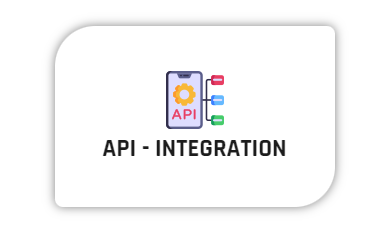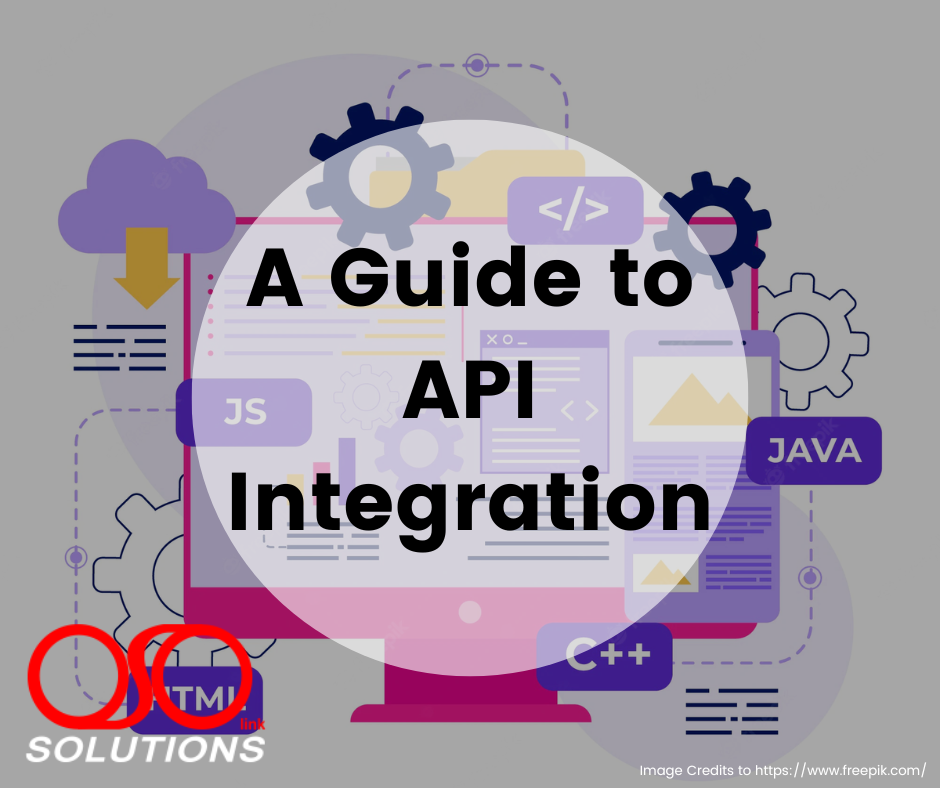API Integration enable companies to automate tasks, integrating their programs and databases with current industry applications. They ensure a smooth and continuous communication between various applications and allow workers to get the benefits of multiple cloud-based apps whilst enhancing product innovation.
What’s an API?
API stands for Application Programming Interface, so we’ll start by learning what an interface is. API integration also refers to the system-to-system connection, via APIs, allowing those two systems to exchange data. APIs are designed so you can use a system remotely and connect systems, people, IoT devices, and more.
Two or more systems that have APIs can interoperate in real-time using those APIs, which saves time, money, and is far more reliable in terms of information currency and data accuracy.

How do APIs Work?
APIs are sets of definitions and protocols that allow software components to talk and interact with each other using a simple set of commands. Acting as messengers, APIs deliver one application’s request to another and return a response in real time. API Integration
If the server (the application providing the resource) can do what the client (the requesting application) asked. Then the API will bring back the resource needed or a status code that roughly translates into mission accomplished. If the server can’t do what the client asked — maybe the client requested a resource that doesn’t exist or that it doesn’t have permission to access. Then the API will return with an error message.
Controlling access to the server in this way is crucial. Rather than give you all of a program’s information or code, an API provides you only with data that has been made available to external users.
API Calls
An API call is the process of a client application submitting a request to a server’s API. An API call also comprises everything that happens after the request is submitted, including when the API retrieves information from the server and delivers it back to the client.
Request Methods
Most clients want the server to carry out basic functions. These requests may be written as URLs so that the communication between client and server is dictated by the rules of Hyper-Text Transfer Protocol (HTTP). The four most basic request methods to a server are:
- GET: To retrieve a resource
- POST: To create a new resource
- PUT: To edit or update an existing resource
- DELETE: To delete a resource
Still confused? Let’s try an analogy. How APIs work is often compared to ordering food at a restaurant, in which you, the diner, represent the client, the waiter represents the API, and the chef represents the server. You look over the menu, pick the meal you want, and place your order with the waiter. The waiter brings your request to the chef. The chef executes on it. Then, the waiter brings you your meal and you enjoy it all the better for not having had to make it yourself. API Integration
But let’s say too many guests show up at the restaurant and there’s not enough space to accommodate them. Let’s say this keeps happening as the restaurant grows in popularity. What then? That’s where API keys come in.
What is an API Key?
An API key is a unique identifier used to authenticate calls to an API. The key is made up of a string of letters and numbers that identify the client. The key can grant or deny that request based on the client’s access permissions, and track the number of requests made for usage and billing purposes.
While not as secure as authentication tokens, this method has some advantages over basic authentication, which only requires a username and password. API Integration
By restricting access only to those with keys, a company can control the number of calls made to its API and ensure that only a specific, trusted group of clients can access its server’s resources.
Continuing our example above, think of an API key like a reservation and the API as an exclusive restaurant. By enforcing that patrons must have a reservation to eat at the restaurant, you can keep the number at capacity so that the kitchen can adequately and efficiently serve every guest. Similarly, by allowing only clients with an API key to access and use your resources made available via the API, you help ensure your software is used safely and can handle the number of requests coming in. API Integration
What are APIs Used For?
A better question might be what are APIs not used for. Want to embed Instagram photos on your e-commerce app? There’s an API for that. Want to provide instant access to thousands of hotels on your travel blog? There’s an API for that. Want to integrate a Yoda translator on your Star Wars fan fiction site? If you can believe it, there’s an API for it. API Integration
Generally speaking, business applications of APIs include:
- Data sharing: Any time a program needs to get data from a third party (e.g., a travel app compiling flight times from airlines, an e-commerce site getting your payment information from a payment processor), data can be shared through an API.
- App integrations: When two digital applications work in conjunction, — HubSpot and Gmail, for example — it’s likely that an API is involved.
- Embedded content: To embed a piece of content that is not hosted by the same company as the website itself – like a YouTube video or a third-party script like Google Analytics — a request is made to the owner of the embedded content to retrieve it.
- Internal systems: APIs aren’t only for sharing data externally. Businesses frequently divide their software infrastructure into smaller components that communicate with each other through APIs, like in a microservice architecture.
Types of APIs
APIs can be categorized by their intended audience and scope. There are four main types of APIs that developers work with:
- Private APIs: These APIs are only available to a company’s internal team in order to boost productivity and transparency. Developers working for the company can use these APIs as needed but third-party developers can’t.
- Partner APIs: These APIs are shared externally, but only with those who have a business relationship with the company providing the API. Some businesses use partner APIs because they want control over who can access their resources and how those resources get used.
- Open APIs: Open APIs, also known as public APIs, are available for external use. While some open APIs are free, others require a subscription fee to use, which is often tiered based on usage.
- Composite APIs: These APIs allow you to bundle calls or requests to get one unified response from different servers. If you need data from different applications, you would use a composite API. Or, instead of making five separate API calls in succession, you can make one using a composite API.
Why Use an API?
Now that we know that businesses can use APIs to securely request and share content, services, and functionalities with both internal and external audiences, you might be thinking why would a company pay another for access to resources that it could create on its own? Why would that company agree to share its assets, particularly with competitors? Or why would it put in all the work of making an API just so its own workforce could use it? API Integration
All good questions. Before we dive into the answers, let’s split up the benefits of APIs into two groups: API consumers and API providers.
Benefits to API Consumers
You may use APIs to request access to another server’s resources or you may use your own APIs to automate certain tasks. Either way, you fall under the mantle of API consumers. These consumers benefit from using each type of API in several ways. API Integration
Productivity
Many companies consume their own APIs. Why? Using APIs internally enables the workforce to streamline operations, foster collaboration, and strengthen transparency across the company. Developers built or turned their well-developed software components into APIs; establishing consistent and well-managed ways of exchanging data and capabilities across the company as a result.
User Satisfaction
Companies want to provide the best experience for their users. Rarely can one product satisfy and anticipate every need and expectation. That is why they use APIs to extend the functionality of their products. For example, OpenTable uses the Maps JavaScript API to embed an interactive map on its site; making it possible for users to get directions from their homes to nearby restaurants in just a few clicks. If you’re not familiar with the site, check out this screenshot showing an overview of a steakhouse in Indiana.
Innovation
By allowing developers — whether third-party or internal members of your workforce — to reuse software components, APIs empower them to focus on developing new solutions rather than repeat work that’s already been done. Let’s revisit the example above. Without the Google Maps API, developers at OpenTable would have to dedicate their time and resources to drawing their own map and providing real-time map data to include this feature on its site. Worse still, no matter how much time they put in; it would be nearly impossible to make it as detailed or reliable as Google’s existing solution. So, instead of wasting their time trying to reinvent the wheel; APIs enable developers to focus on creating new tools and functionality that deliver more value to their users.
Benefits to API Providers
Now that you know the benefits of using APIs, let’s turn our attention to why you might want to create and then share one with partners or the general public.
Simply put, becoming an API provider unlocks business opportunities and other benefits that build upon those of simply consuming APIs. Let’s look into each one below.
Revenue
The easy answer is money. Google, Yelp, Facebook, and thousands of other companies make their APIs public and monetize them so that they become additional lines of revenue. In fact, at some companies, APIs are the major source of revenue. According to a recent report by MuleSoft Inc., 35 percent of today’s technology leaders generated more than a quarter of their organizations’ revenue as a direct result of APIs.
Scale
By sharing what you do really well with the broadest possible audience, a network of users beyond your employees and customers—including third-party developers and consumers—will become reliant on the data and functionality provided by your APIs. Ultimately, this will improve the usage and adoption of your main platform. In other words, APIs not only expand your customer base, they generate new market opportunities in the digital economy.
Amazon Web Services (AWS) is among the most notable examples. This platform, which essentially allows any company or developer to run its applications on top of Amazon’s technology infrastructure platform via APIs, is used by millions of customers around the world and is credited with transforming Amazon from an online bookstore to a global digital giant.
Even More Innovation
Yes, I’m listing this again, but with a twist. Above, we discussed how API consumers benefit from using third-party solutions that allow them to focus their time and resources on making their own products better rather than reinventing the wheel.
More often than not, however, the relationship between API consumers and providers is much more give-and-take. You may recall that in the early days of Twitter, its user interface was a little clunky. Then TweetDeck, an independent app at the time, came along and built a better user interface on top of the Twitter platform using its public API so that all users could have better Twitter experiences. That’s what we call a win-win-win, my friends.
How to Use an API?
So you’re ready to try your luck with APIs. Now what? Before implementing your own API at your company, it makes the most sense to use others’ APIs. Let’s walk through the basics of how you’d get started using an API.
Select an API.
First things first, you’ll want to find an API you could incorporate into your business. You might already have your eye on an API; particularly if you’re interested in one of the big wigs like the Facebook API. You might also want to search by cost — you may want to start with a free API before exploring paid APIs, for example.
Once you have an API selected, get your reading glasses on. It’s time to look through the API documentation.
Get an API Key.
As mentioned, an API key is used to identify yourself as a valid client, set access permissions, and record your interactions with the API.
Some APIs make their keys freely available, while others require clients to pay for one. Either way, you’ll most likely need to sign up with the service. You’ll then have a unique identifier assigned to you, which you will include in your calls.
Always key your key private, like you would a password. If your key leaks, a bad actor could make API requests on your behalf. You may be able to void your old key and get a new one if such a breach occurs.
Review the API Documentation.
API Documentation is essentially an instruction manual about how to effectively use and integrate with an API. In addition to providing all the information required to work with the API; like whether or not you need an API key, it usually includes examples and tutorials.
Refer to the documentation for how to get your key, how to send requests, and which resources you can fetch from its server.
It’s hard to understate the importance of good API documentation — a company might offer a powerful API, but if developers can’t quickly learn how to use it, it’s not very valuable
Write a Request to an Endpoint.
Next up, you’ll write your first request. The easiest method is to use an HTTP client to help structure and send your requests. You’ll still need to understand and get some information from the API’s documentation, but you won’t need much coding knowledge to be successful.
At this stage, online tutorials can come to the rescue. For example, this YouTube video explains how to use an API to pull location data from Google Maps and then use those coordinates to find nearby photos on Instagram.
Connect Your App.
Now that you understand how to make requests to your API of choice, you can sync your application with it. As a marketer, you don’t need to worry about this stage of an API integration. This is the job of a developer, who will employ one or more languages like Python, Java, JavaScript (and NodeJS), PHP, and more.
Chances are, the API you’re interacting with is a specific type of API that is considered easier to use than others. They called these APIs as REST APIs.
—
Read more of our blogs.
1st Source: https://blog.hubspot.com/website/application-programming-interface-api
2nd Source: https://www.cleo.com/blog/what-is-api-integration
3rd Source: https://snipcart.com/blog/integrating-apis-introduction
4th Source (Image Credits to): https://www.freepik.com/free-vector/hand-drawn-flat-design-api-illustration_25001216.htm#query=api%20integration&position=41&from_view=keyword
“No copyright infringement is intended”

Read more Blogs
Learn more about us. Feel free to contact us.


